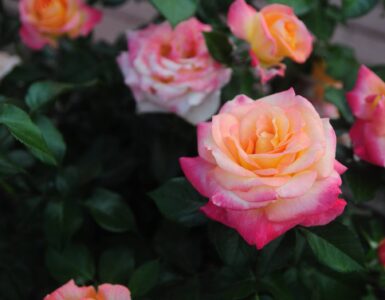We built our garden box and planted our veggies. Now it’s time to protect those plants from Utah’s most common pests.
Emily Saddler from the Jordan Valley Home & Garden Club shows us how to keep bugs at bay using items you already have at home.
During these hot summer months pest problems can become overwhelming if allowed to get out of hand. There are 3 main controls used for keeping pests at bay:
· Mechanical – Hand pick insects and eggs off plant.
· Biological – Plant certain types of herbs and flowers that attract beneficial insects (this is also known as companion planting).
· Chemical – Organic and non-organic chemicals are included in this category.
The struggle between whether or not to spray organic vegetables with chemicals can be a burden. Although chemical pesticides are needed at times, they are over used and can be extremely dangerous to humans, the environment and animals. I recommend using a chemical pesticide as a last resort to save an ornamental plant, though I would likely remove the vegetable or edible plant rather than consume the residual chemical later. Be sure to read all labels carefully, mix at the recommended concentrations (if some is good, more is not better) and discard waste as directed.
There are any number of bugs that plague our gardens but today we’ll focus on the worst offenders! We’ll create a bit of a bug “hit list” and provide recipes for DIY organic solutions that can help reign in those unwated populations!
PROBLEM:
Snails
Snails can be detrimental to the vegetable and flower gardens. They eat pretty much everything and fast because they can multiply quickly! It’s best to get a handle on this pest as soon as possible since they can lay up to 100 eggs within a few days. One of the best ways to get rid of snails is to go out very early in the morning as the sun rises and hand pick snails off plants throwing them into a soapy bucket of water or a seal-able plastic bag to be thrown into an outside garbage can.
SOLUTION:
Another way to rid snails is to put beer or a sugar/yeast and water mixture into a pie plate or tuna cans. Dig the shallow dish into the ground so it is flush with the soil. The snails will be attracted to the beer or sugar/yeast water and drowned. If the infestation is really bad use snail bate, a chemical solution, that can be used to get control of the problem.
PROBLEM:
Aphids
Aphids are detrimental in numbers! A single aphid can produce up to 600 billion offspring! As you can see from the picture above the damage of many plants can kill a plant or bring it close to death. Some symptoms of aphids on plants are wet honeydew secretions, sticky looking leaves with hundreds of aphids on the underside of them, curling leaves and blossoms that begin become necrotic, making them turn black or even small webbing all over. Aphids feed on sap from shoots, leaves, flowers and buds. These little guys are too little and to large in numbers to mechanically be removed. I like to make a homemade recipe with garlic and liquid soap to spray on them, suffocating their soft bodies.
SOLUTION:
To make the garlic spray: puree 1 bulb of garlic with 1/2 cup water. Add 2 tablespoons plant based liquid dish washing soap and cayenne pepper for a stronger concoction. Allow to steep for a few hours or overnight. Pour the mixture through a sieve and cheese cloth. Add more water and the garlic mixture to a spray bottle and spray! Apply every 3-4 days until the problem is eradicated.
PROBLEM:
Squash Bugs
My arch nemesis! Squash bugs can take over in no time if you don’t know what you are looking for! These life sucking insects literally suck the water right out of the plant in just a few hours, leaving it looking like it hasn’t been watered in weeks.
The plant leaves become droopy, necrotic and black. A good fierce spray of the hose will bring the adults out from underneath their hiding places making it easier to hand pick them. Be sure to have a soapy bucket of water for them to drowned in! The copper colored eggs can be found on the undersides of the leaves in a cluster. Be sure to remove as many as you can and crush them, then throwing them into the bucket of soapy water. It is best to go out every day for a few minutes and remove them by hand until they are all gone. If that isn’t good enough try using Neem Oil.
SOLUTION:
This organic chemical comes from the seeds of the neem tree. Neem oil interferes with insect hormones leaving them unable to grow and reproduce. When using any pesticide, including organic products, be sure to read all labels and use as directed. Neem oil is also toxic for honey bees. It is best to apply before 7am or after 7pm when most beneficial insects have left for the evening.
PROBLEM:
Leaf Miners
Leaf miners love to eat spinach, Swiss chard, beet greens and other leafy greens. The adult fly lays little white eggs on the back of the leaf. Once hatched they burrow into the inner layer of the leaves, leaving trails of dead vegetation in their wake. The best way to keep these under control is to plant nectar and pollen loving plants that attract parasitic wasps. See part one for a brief list.
SOLUTION:
Using fabric row covers is an excellent way to keep them away. Cover in the spring and bury the edges of the row cover around the grow box or soil. Use a light enough fabric to allow water and sun penetration for growth. If you choose not to use the fabric row cover it is important to look for the eggs as the first of the greens start to grow. Remove them if you see any until the problem has stopped. Neem oil can be used as a last resort. A side benefit of the floating row cover is that is also keeps neighborhood critters, like cats, out of garden beds!
*Special thanks to the Utah State University Extension who combed through their photos and provided the ones we needed for this post!















Add comment